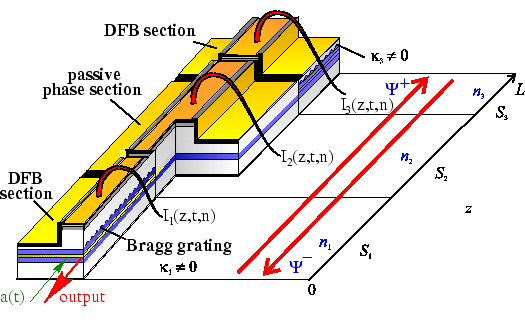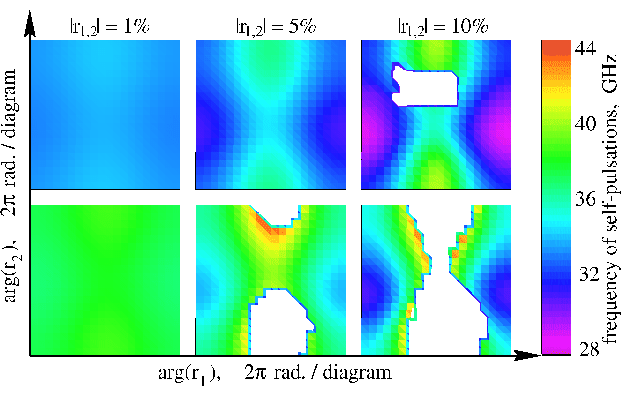
|
|
|
|
[Contents] | [Index] |
Cooperation with: B. Sartorius, D. Hoffmann, H.-P. Nolting, O. Brox, S. Bauer (Heinrich-Hertz-Institut für Nachrichtentechnik, Berlin (HHI)), H.-J. Wünsche (Institut für Physik, Humboldt-Universität zu Berlin (HU)), L. Recke (Institut für Mathematik, Humboldt-Universität zu Berlin (HU)), H. Wenzel (Ferdinand-Braun-Institut für Höchstfrequenztechnik, Berlin (FBH)), M. Umbach (u2t Photonics AG, Berlin), U. Bandelow (WIAS: Research Group 1)
Supported by: BMBF: ``Hochfrequente Selbstpulsationen in Mehrsektions-Halbleiterlasern: Analysis, Simulation und Optimierung'' (High frequency self-pulsations in multi-section semiconductor lasers: Analysis, simulations, and optimization),
DFG: SFB 555 ``Komplexe Nichtlineare Prozesse''
(Collaborative Research Centre ``Complex Non-linear Processes''), DFG-Forschungszentrum ``Mathematik für Schlüsseltechnologien'' (DFG Research Center ``Mathematics for Key Technologies''),
Description:
Semiconductor laser devices play a key role in modern telecommunication systems for generating, transforming, and processing data at high speed. For optical networks they provide special components working in complicated nonlinear dynamical regimes (high frequency pulsations, synchronization, short pulses, fast switching).
The mathematical research performed in this project includes
Optical feedback is one of the main possibilities in a laser system to generate instabilities and complex dynamical phenomena. Based on the Lang-Kobayashi model
a system of delay differential equations, we studied in [16] analytically the instabilities of lasers under the influence of moderate delayed feedback. A local center-manifold theorem has been proved in [14]. Using scaling methods, analytic expressions for different types of Hopf instabilities have been derived, leading to different types of pulsations of the laser. Moreover, the dependence of the pulsation frequency on the feedback parameters has been analyzed.
Based on this theoretical insight, a new device concept has been developed at the HHI: An additional amplifying section allows higher and tunable feedback strength. This lead to a new optical microwave source, the Amplified Feedback Laser, which is tunable from 10 to 40 GHz ([18]).
The main tuning (or bifurcation) parameters of this device are the
current injection IA into the amplifier section and the current
injection IP into the
phase tuning section which is equivalent to the phase ![]() of the feedback.
of the feedback.
In order to understand the dependence of the dynamics of the Amplified
Feedback Laser on IA and ![]() , a complete
bifurcation analysis of the two-mode approximation ([19])
of the traveling wave equations ([1]) has been performed.
Figure 2 reveals the regions of self-pulsations of
different types and their borders in the parameter plane
, a complete
bifurcation analysis of the two-mode approximation ([19])
of the traveling wave equations ([1]) has been performed.
Figure 2 reveals the regions of self-pulsations of
different types and their borders in the parameter plane
![]() -IA. A point of particular interest for applications is the
widening of the region of mode-beating pulsations compared to the
setup with passive feedback ([19]).
-IA. A point of particular interest for applications is the
widening of the region of mode-beating pulsations compared to the
setup with passive feedback ([19]).
A further important dynamical regime occurring in lasers with delayed optical feedback is excitability. The theoretical background in the context of homoclinic bifurcations for excitability in different laser systems has been studied in [17]. Corresponding experimental results for the case of lasers with delayed feedback and corresponding numerical simulation results have been presented in [6].
The software LDSL-tool has been developed for the simulation and analysis of longitudinal dynamics in multisection semiconductor lasers. The underlying laser model is based on the traveling wave (TW) equations for the optical field propagating along the longitudinal axis of the laser ([1, 5]).
The agreement between simulations by LDSL-tool
and experimental results
is demonstrated in
Figure 3 (see also [7, 8]),
where the maximal field intensity of periodic
solutions or stationary states in a 3-section DFB laser
is represented in dependence on some parameter ![]() .Moreover, this figure can serve as an illustration of more advanced
possibilities of LDSL-tool which are discussed below.
Dashed brown and green lines show stable solutions observed in experiments (above)
and in simulations of the TW model (below) for
increasing and decreasing parameter
.Moreover, this figure can serve as an illustration of more advanced
possibilities of LDSL-tool which are discussed below.
Dashed brown and green lines show stable solutions observed in experiments (above)
and in simulations of the TW model (below) for
increasing and decreasing parameter ![]() .Solid red and blue lines show stable and unstable solutions
of the system representing a two-mode approximation.
Different bifurcations and regions where excitable
behavior of a laser can be expected are indicated by thick symbols and
yellow shading.
.Solid red and blue lines show stable and unstable solutions
of the system representing a two-mode approximation.
Different bifurcations and regions where excitable
behavior of a laser can be expected are indicated by thick symbols and
yellow shading.
|
|
|
The structure of LDSL-tool is discussed in [8, 10] and is represented by a brief schema in Figure 4. Here, blue, green and yellow boxes indicate the hierarchy of models, computational efforts and different data representation/processing procedures, respectively. Blue arrows show transitions which can be done only for some simplified models under some additional assumptions.
The potentialities of LDSL-tool are extended continuously. Besides of numerical integration of different TW models, LDSL-tool performs some post-processing procedures on the computed data stream ([5, 9]), solves spectral problems defining longitudinal modes of the optical field, and allows to study the dynamics of these modes ([3, 6]). Under some assumptions, the software can be used to perform model reductions, to integrate reduced mode approximation (MA) systems ([13]), and to compare their solutions with the solutions of the full TW model ([6, 8]). Moreover, a bifurcation analysis of MA systems allows to identify different types of the transition between dynamical regimes in the TW model [7]. After finding a good agreement between experiments and simulations by LDSL-tool (see [3, 5, 10] and comparing brown/green dashed lines in upper and lower diagrams of Figure 3), one is able not only to explain the origin of dynamics in the lasers (see bifurcations indicated in lower part of Figure 3), but also to predict some dynamical effects, such as excitable behavior of lasers (yellow shaded regions in Figure 3) realized later in experiments [4, 6].
At present, the software is successfully used by coworkers of the Department of Physics of the Humboldt University, of the Heinrich Hertz Institute, and of the Ferdinand Braun Institute to simulate and to analyze the behavior of different lasers. In particular, LDSL-tool is applied to study excitability in lasers with short external cavity ([4, 6]), self-pulsations in lasers with amplified feedback ([11, 12]), in DFB lasers with dispersive feedback ([1, 5, 7]), in lasers with two active DFB sections ([3, 9, 10]), and high power pulse generation in DBR lasers ([15]).
In the frame of the BMBF project ``Hochfrequente Selbstpulsationen in Mehrsektions-Halbleiterlasern: Analysis, Simulation und Optimierung'' (High-frequency self-pulsations in multi-section semiconductor lasers: Analysis, simulations, and optimization), in cooperation with the Heinrich Hertz Institute, Berlin, and the company u2t Photonics, Berlin, the behavior of a three-section laser with two active DFB sections (see Figure 1) has been investigated.
It was demonstrated experimentally and theoretically
([3])
that such a laser
can operate at high frequency (![]() 20-160 GHz) self-pulsations (SP) due to mutual action of two
modes. Nevertheless, only some of the produced
nominally identical devices could operate at the required pair of
modes. The identification of possible reasons
for this failure is one of the most important tasks in this project.
By extensive numerical simulations of the impact of several
possible limiting effects it was possible to avoid a lot of time-consuming
and expensive experiments and measurements.
20-160 GHz) self-pulsations (SP) due to mutual action of two
modes. Nevertheless, only some of the produced
nominally identical devices could operate at the required pair of
modes. The identification of possible reasons
for this failure is one of the most important tasks in this project.
By extensive numerical simulations of the impact of several
possible limiting effects it was possible to avoid a lot of time-consuming
and expensive experiments and measurements.
Finally, in [10] we have suggested that such problems can arise due to non-vanishing reflectivities for the counter-propagating fields at the junctions of the laser sections S1/S2 and S2/S3. Since the phases of the complex reflectivity coefficients r1 and r2 can not be controlled during the production of the devices, it is important to estimate the reflectivity amplitudes |r1,2| permitting the same type of SP for any phase of reflectivity in order to find conditions which guarantee a robust behavior under the requirements of the production process.

|
The diagrams in Figure 5 represent a study of the effect of
internal reflectivity on two slightly different self-pulsations at 33.5
and 38 GHz frequency. The SP represented in the upper diagrams are chosen
from the middle of the area of similar self-pulsations in the parameter
space, while the lower diagrams indicate similar SP closer to the border of
the same area. In both cases we have applied the same reflectivity
amplitudes for both of the junctions (fixing them at 1, 5, and 10 ![]() reflectivity) and have varied the reflectivity phases.
reflectivity) and have varied the reflectivity phases.
The white areas within the colored diagrams indicate totally different
operational regimes. Therefore,
5 ![]() amplitude reflectivity (which, actually, was present in the lasers
made at the Heinrich Hertz
Institute) do not degrade self-pulsations
dramatically if we are in the middle of the SP area in the
parameter plane, but can cause trouble if we are operating close to the
border of the same area.
amplitude reflectivity (which, actually, was present in the lasers
made at the Heinrich Hertz
Institute) do not degrade self-pulsations
dramatically if we are in the middle of the SP area in the
parameter plane, but can cause trouble if we are operating close to the
border of the same area.
These simulations have shown the importance of a control of internal reflectivities. Our partners now are producing a new generation of multi-section lasers with reduced level of reflectivities.
References:
|
|
|
[Contents] | [Index] |